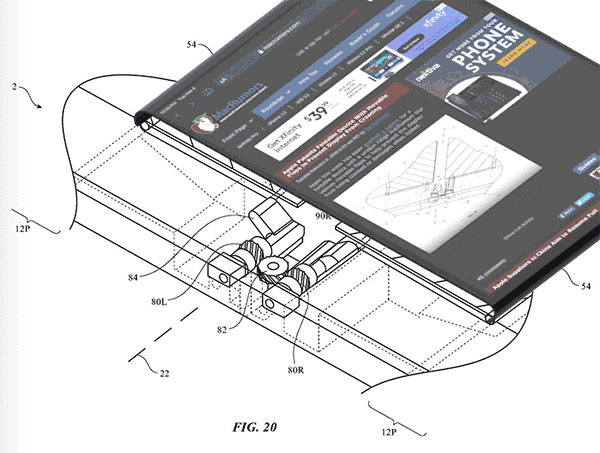A new Apple patent might give us an idea of how the company plans to solve the problem of foldable displays creasing during use.
Phones like the Galaxy Fold from Samsung have a very clear crease down the middle of their screens and to say it’s unsightly is an understatement. But Apple seems to have a solution that it thinks will allow it to make a foldable iPhone or iPad without such issues.

The patent is titled “Electronic devices with flexible displays and hinges” and was first spotted on Tuesday. While it’s filled with decidedly opaque language, it does seem to suggest that Apple’s engineers want to bend the display outwards slightly before folding it back on itself. That, the patent notes, should enable a larger radius curve and thus prevent any creasing. In theory, at least.
An electronic device may have a flexible display that overlaps an axis. The display may be supported by a housing. The housing may have first and second portions that rotate relative to each other about the axis. The housing may be placed in an unfolded configuration to support the display in a planar state. The housing may also be placed in a folded configuration by rotating the first and second portions relative to each other. A hinge mechanism may be used to ensure adequate separation between the first and second portions when the housing is bent. Movable flaps may be retracted when the housing is bent to create room for a bent portion of the display.
A hinge mechanism may be used to ensure adequate separation between first and second portions of the housing when the housing is bent. This ensures that the flexible display can maintain a desired minimum bend radius in the vicinity of the bend axis. The hinge mechanism may be based on a rack-and-gear arrangement or other arrangement that maintains the first and second housing portions at a desired distance from each other.
With another arrangement, the housing may have movable flaps that extend parallel to the bend axis. The movable flaps may be placed in a planar configuration to support the display when the housing is in its unbent state. The movable flaps may be retracted when the housing is placed in its bent state. This creates room for a bent portion of the display along the bend axis.
Perhaps the mechanism is best explained by an animation from MacRumors seen below:

Samsung isn’t the only company to have gone the foldable route in recent months with the Motorola RAZR having just gone on sale. But it, too, seems to have a similar creasing problem to the one Apple is clearly trying to avoid with this patent.
It’s important to remember that Apple patents almost everything its engineers come up with. Not all patents turn into products that you can buy, either. So while this patent does look very interesting, it doesn’t necessarily mean that a foldable iPhone or iPad is around the corner. Or even that it’s going to happen at all.
It’s good to know that if we do get a foldable Apple device, it at least shouldn’t crease.
(Source: USPTO)
You may also like to check out:
- Checkra1n For Windows Alternative: How To Use Ra1nUSB For iOS 13.3 Jailbreak
- Download: iOS 13.3.1 Final IPSW Links, OTA Update And iPadOS 13.3.1 Released For Compatible Devices
- Downgrade iOS 13.3.1 To iOS 13.3 For Checkra1n Jailbreak, Here’s How
- Jailbreak iOS 13.3 Using Checkra1n, Here’s How [Guide]
- Jailbreak iOS 13.3 / 13.3.1 On iPhone 11, 11 Pro Max, XS, More With New tfp0 Exploit Will Be Possible Soon
- iOS 13 / 13.2.2 Jailbreak Tweaks Compatibility List For Checkra1n
- Apple Watch ECG App Hack: Enable Outside US In Unsupported Country On Series 5 & 4 Without Jailbreak
You can follow us on Twitter, or Instagram, and even like our Facebook page to keep yourself updated on all the latest from Microsoft, Google, Apple, and the Web.

